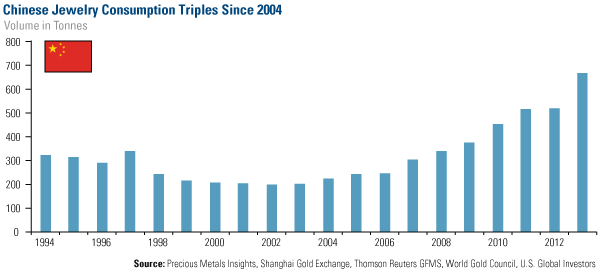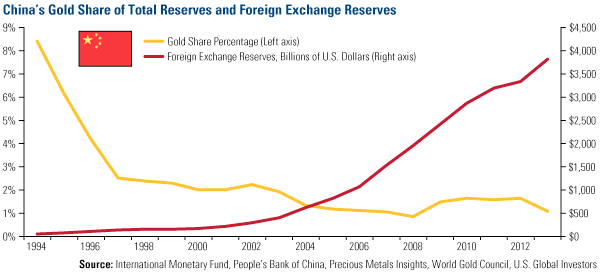China Holds the Keys to the Gold Market
Commodities / Gold and Silver 2014 Apr 29, 2014 - 09:16 AM GMTBy: Frank_Holmes
 Last year China's private-sector demand for gold reached a record level of 1,132 tonnes, and according to the World Gold Council (WGC), the Asian nation could easily dominate the gold market once again, as they predict demand growing 20 percent by 2017.
Last year China's private-sector demand for gold reached a record level of 1,132 tonnes, and according to the World Gold Council (WGC), the Asian nation could easily dominate the gold market once again, as they predict demand growing 20 percent by 2017.
This updated projection from the WGC confirms what I've written about previously: China's love for the precious metal remains robust. We are witnessing this country transform into an economic powerhouse, and now, the world's largest gold market! I think it's important for investors to recognize the main drivers behind this tremendous growth.
1. A new middle class has more money to spend.
Despite all the grandiose numbers we see in China's gold market, the Asian nation hasn't always been the "golden goose" of the game. The WGC points out in its recent report, China's Gold Market: Progress and Prospects, that only in the last several years has China seen an emerging middle class supported by higher incomes. For example, Shenzhen is currently a city with over 10 million people, accounting for 70 percent of China's jewelry fabrication. Just 30 years ago however, it was only a small town of around 330,000 people, meaning consumer demand for gold at that time was minimal at best.
Over the last 10 years however, a new middle class has emerged and consumers have been enjoying their new wealth. As GDP began to rise, people started buying more gold jewelry and coins. In addition to increased spending on these items, the investment demand for the yellow metal progressed as the population sought a hedge against inflation.
2. Jewelry is still the top demand driver.
The WGC report also reaffirms the ongoing power of the Love Trade. The Love Trade, one of the two main drivers of gold along with the Fear Trade, relates to the cultural affinity for the precious metal particularly in Asia, India and the Middle East. Consumers continue to purchase gold jewelry and coins year-after-year, and demand rises in synch with gift giving for religious holidays and celebrations.
As you can see in the chart below, since 2004 the volume of gold jewelry consumed in China has tripled.
What's more, China surpassed India as the world's largest consumer and manufacturer of jewelry in 2013. According to a recent Reuters' article, gold jewelry sales in India slowed by 10 percent since import restrictions were imposed on the country last year - a likely factor placing China in the top spot.

3. Industrial demand is increasingly important.
Though not nearly as strong as the gold jewelry demand in China, the country's rise in GDP has also increased industrial demand for gold. The WGC says that electronics are the dominant source of this industrial demand. Gold is used in cellphones, computers, circuit boards and recently the automobile industry has seen an increased demand for the metal.
Gold may seem like an expensive option to choose from to build cellphone parts or airbag connectors in vehicles, but as the report states, "Although manufacturers are always trying to reduce the cost of components and substitute gold with lower cost alternatives, this cannot be done where optimum performance and, especially, safety concerns are to the fore."
In our slideshow, The Many Uses of Gold, we explain other ways gold is used; not only for industrial needs, but for medical and technological advances as well.
4. China is diversifying away from the U.S. dollar.
When it comes to foreign exchange reserves, China's totalled $3.8 trillion U.S. dollars in 2013, a sharp increase from the mid-90s as you can see in the chart below. There are several challenges facing the Asian nation's monetary system too; the multi-currency system which includes the renminbi and the dollar is no easy task to manage.
But how are China's foreign exchange reserves and monetary troubles a driver for gold demand?

For starters, according to the WGC, the majority of growth in China's reserves (implied specifically by the country's current account surplus) has been in U.S. dollars. China used the dollar to buy American debt securities, but upon the global financial crisis and the start of quantitative easing (QE), China has been pulling away from exposure to the dollar.
In a recent article from Casey Research, Chief Economist Bud Conrad even comments on the decline of the dollar's reserve status in foreign countries such as China. He says, "In 2000, the dollar accounted for 55 percent of all foreign exchange reserves. In 14 short years, that number has dropped to 33 percent. By 2020, I project, it will drop to 20 percent. At that point, other large economies of the world won't need dollars nearly as much for international trade."
I believe that government policy is a precursor to change, so as fiscal and geopolitical challenges rise between the two countries, it's no wonder China wants to back away from the dollar and thus, diversify to gold. Gold is a hard asset, making it a prime currency choice for China. In regards to gold, the WGC report even states that, "It cannot be created out of thin air at the whim of central banks. Nor can it be manipulated for the benefit of its issuer."
So what is China up to now?
So perhaps the People's Bank of China is amping up its gold reserves to diversify away from the U.S., but one question remains. Exactly how much gold does China have?
As Mineweb reported this last week, China deemed Beijing as an additional import city for gold, a clear indicator even more of the precious metal will find its way into the country. China does not release any official numbers about its gold imports, so Beijing will be another source of unpublished data. Rather than reporting its own gold traffic, other countries report their gold export data to China. Hong Kong provides insight into China's gold holdings and in February I wrote how Switzerland released its gold trade data this year for the first time since 1980. Only through these alternate reports can we infer the amount of gold China truly holds.

No matter the exact amount of gold that China has, this country is a good example that the demand drivers for gold remained the same. People around the world react with concern over government policies that can devalue currencies, thus making gold attractive. Similarly, as economies flourish and people have money, they will spend it on gold. The Love Trade will also continue; consumers will purchase gold as gifts as long as cultural celebrations and religious traditions carry on.
It's important to follow the money, or in this case the gold, to see how people around the world react to this rare commodity. Looking forward, stay curious as an investor and you'll see if China can keep the key to the gold market.
Want to receive more commentaries like this one? Sign up to receive email updates from Frank Holmes and the rest of the U.S. Global Investors team, follow us on Twitter or like us on Facebook.
By Frank Holmes
CEO and Chief Investment Officer
U.S. Global Investors
U.S. Global Investors, Inc. is an investment management firm specializing in gold, natural resources, emerging markets and global infrastructure opportunities around the world. The company, headquartered in San Antonio, Texas, manages 13 no-load mutual funds in the U.S. Global Investors fund family, as well as funds for international clients.
All opinions expressed and data provided are subject to change without notice. Some of these opinions may not be appropriate to every investor.Standard deviation is a measure of the dispersion of a set of data from its mean. The more spread apart the data, the higher the deviation. Standard deviation is also known as historical volatility. All opinions expressed and data provided are subject to change without notice. Some of these opinions may not be appropriate to every investor. The S&P 500 Stock Index is a widely recognized capitalization-weighted index of 500 common stock prices in U.S. companies. The NYSE Arca Gold BUGS (Basket of Unhedged Gold Stocks) Index (HUI) is a modified equal dollar weighted index of companies involved in gold mining. The HUI Index was designed to provide significant exposure to near term movements in gold prices by including companies that do not hedge their gold production beyond 1.5 years. The MSCI Emerging Markets Index is a free float-adjusted market capitalization index that is designed to measure equity market performance in the global emerging markets. The U.S. Trade Weighted Dollar Index provides a general indication of the international value of the U.S. dollar.
Frank Holmes Archive |
© 2005-2022 http://www.MarketOracle.co.uk - The Market Oracle is a FREE Daily Financial Markets Analysis & Forecasting online publication.



